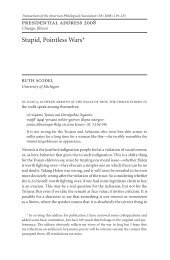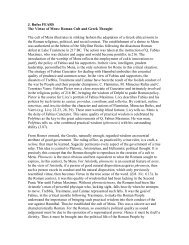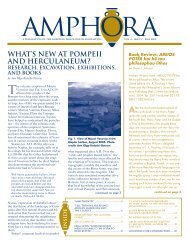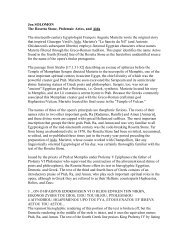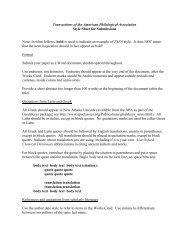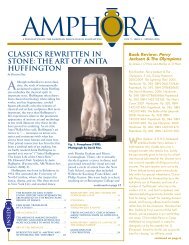Augustan Literature and Religion at Rome
Augustan Literature and Religion at Rome
Augustan Literature and Religion at Rome
Create successful ePaper yourself
Turn your PDF publications into a flip-book with our unique Google optimized e-Paper software.
<strong>Augustan</strong> <strong>Liter<strong>at</strong>ure</strong> <strong>and</strong> <strong>Religion</strong> <strong>at</strong> <strong>Rome</strong><br />
Celia E. Schultz<br />
University of Michigan<br />
I have taken the invit<strong>at</strong>ion to particip<strong>at</strong>e in the APA’s panel on Apollo, Augustus, <strong>and</strong> the<br />
Poets as an opportunity to reconsider the rel<strong>at</strong>ionship between liter<strong>at</strong>ure <strong>and</strong> religion <strong>at</strong> <strong>Rome</strong>.<br />
As my students often observe, there appears to be a disconnect between the way the gods are<br />
portrayed in liter<strong>at</strong>ure, especially poetry, <strong>and</strong> the way they seem when we look <strong>at</strong> them through<br />
inscriptions <strong>and</strong> historical accounts of ritual. How closely connected are those literary portrayals<br />
to contemporary daily religious life? We can see the stories about the gods in the artistic<br />
decor<strong>at</strong>ion of temples <strong>and</strong> altars, <strong>and</strong> those same stories are present in some of the few examples<br />
of Roman prayers <strong>and</strong> hymns we possess. But do they reflect real thoughts <strong>and</strong> beliefs? Are they<br />
rel<strong>at</strong>ed to ritual?<br />
John Miller’s thoughtful <strong>and</strong> thorough book raises these same questions again as it shows<br />
us how poets writing in the age of the Emperor Augustus presented <strong>and</strong> re-presented the multi-<br />
faceted figure of Apollo. The god is <strong>at</strong> once Greek <strong>and</strong> Roman, citharode, poet, prophet,<br />
avenger, <strong>and</strong> guardian; he is as malleable <strong>and</strong> changeable, <strong>and</strong> as active a locus of intertext as<br />
many other elements in those same works. In the poetry of the <strong>Augustan</strong> age, Apollo is a site<br />
where “literary <strong>and</strong> political discourse can intersect.” 1 Accordingly there is a lot in Apollo,<br />
Augustus, <strong>and</strong> the Poets for literary <strong>and</strong> cultural criticism, <strong>and</strong> also for the history of politics.<br />
Yet even though Professor Miller’s book focuses on a god, it is not immedi<strong>at</strong>ely obvious how<br />
this literary Apollo rel<strong>at</strong>ed to the god worshipped publicly <strong>and</strong> priv<strong>at</strong>ely in Italy as early as the<br />
1 Miller (2009), 298.
Schultz 2<br />
seventh century BCE <strong>and</strong> by the Roman st<strong>at</strong>e by <strong>at</strong> least the l<strong>at</strong>e fifth century. 2 Nor is it clear<br />
wh<strong>at</strong> effect Professor Miller’s demonstr<strong>at</strong>ion of the complexities <strong>and</strong> nuance of poetic discourse<br />
about Apollo should have on current work on Roman religion, by which I mean the study of the<br />
Romans’ thoughts <strong>and</strong> beliefs about their gods <strong>and</strong> the rituals they observed in their honor.<br />
This curious disjuncture is in no way the result of any deficiency or oversight in<br />
Professor Miller’s work, nor is it unique to writings about, <strong>and</strong> rituals for, Apollo. There is a<br />
long-lived tendency in modern scholarship by specialists in all the relevant subfields to tre<strong>at</strong> the<br />
stories of the divine (th<strong>at</strong> is, myths) told by Romans as literary <strong>and</strong> artistic phenomena r<strong>at</strong>her<br />
than as religious ones. The study of Roman liter<strong>at</strong>ure <strong>and</strong> the study of Roman religion have<br />
proceeded along two separ<strong>at</strong>e tracks th<strong>at</strong> sometimes run more closely together than others but do<br />
not merge very often. Because this is the case far beyond the confines of Professor Miller’s<br />
work, I will not address in this paper the specific question: wh<strong>at</strong> should historians of Roman<br />
religion take away from Apollo, Augustus, <strong>and</strong> the Poets? I will instead direct my comments<br />
more widely to suggest th<strong>at</strong> the perceived failure of Roman liter<strong>at</strong>ure <strong>and</strong> religion to engage with<br />
one another is due largely to the aristocr<strong>at</strong>ic bias of our ancient authors <strong>and</strong> our own proclivity to<br />
follow it with insufficient reflection. The question of the rel<strong>at</strong>ionship between liter<strong>at</strong>ure <strong>and</strong><br />
religion is a very timely one. At the same Annual Meeting th<strong>at</strong> is hosting this panel, the Society<br />
for Ancient Mediterranean <strong>Religion</strong> is sponsoring another panel, entitled The Book <strong>and</strong> the Rock,<br />
th<strong>at</strong> investig<strong>at</strong>es the role of liter<strong>at</strong>ure in the study of ancient Mediterranean religions. The issue<br />
2 Apollo was not newly imported in 433: Livy 3.63.1-11 <strong>and</strong> 4.25.3-000 (with Ogilvie’s<br />
commentary) indic<strong>at</strong>e th<strong>at</strong> the site of the temple dedic<strong>at</strong>ed to Apollo Medicus in 431 had already<br />
been a cult site for the god for some time. This is the same temple l<strong>at</strong>er refurbished by Sosius.<br />
See A Viscogliosi, LTUR I. 49-54, s. v. “Apollo, Aedes in Circo”. Linguistic evidence suggests<br />
th<strong>at</strong> his worship by the Romans <strong>and</strong> their neighbors extends back a long way. The Etruscan form<br />
of the god’s name, Aplu, has lost the Greek –n, suggesting th<strong>at</strong> Apollo came into Etruria through<br />
L<strong>at</strong>ium r<strong>at</strong>her than from the Greeks directly (Jannot 2005, 144-5).
Schultz 3<br />
is also current among scholars of other religions, especially those working on early Christianity<br />
<strong>and</strong> Second Temple Judaism. Wh<strong>at</strong> follows is a sketch of how such an argument might be made<br />
for the integr<strong>at</strong>ion of liter<strong>at</strong>ure <strong>and</strong> religion <strong>at</strong> <strong>Rome</strong>: much more remains to be done before the<br />
case will be strong enough to st<strong>and</strong> on its own. Even so, the initial results are promising.<br />
The difficulty of articul<strong>at</strong>ing the rel<strong>at</strong>ionship between liter<strong>at</strong>ure <strong>and</strong> religion <strong>at</strong> <strong>Rome</strong> has<br />
been recognized for a long time. The ancients h<strong>and</strong>led the problem by constructing a tripartite<br />
theology (tria genera theologiae), which distinguished poetic, philosophical, <strong>and</strong> civic ways of<br />
talking about the gods. The idea, developed by Hellenistic Greek thinkers, had widespread <strong>and</strong><br />
long-lived influence in antiquity, 3 not just among intellectuals but among the wider populace as<br />
well. James Rives has pointed out th<strong>at</strong> when the Greek or<strong>at</strong>or Dio Chrysostom mentions, <strong>and</strong><br />
then plays with, the three theologies in a public lecture delivered to a large, popular audience <strong>at</strong><br />
the Olympic Games in the l<strong>at</strong>e first century CE, Dio assumes his listeners were already familiar<br />
with it. 4 The earliest known instance of the tripartite theology being applied to <strong>Rome</strong> came in<br />
l<strong>at</strong>e second or early first century BCE by the Pontifex Maximus Q. Mucius Scaevola (cos. 95).<br />
We have his account only <strong>at</strong> third h<strong>and</strong>: it is preserved in Augustine’s De Civit<strong>at</strong>e Dei 4.27,<br />
where Augustine seems to be working through an intermediary source, widely presumed to be<br />
Varro’s Antiquit<strong>at</strong>es Rerum Divinarum. Varro wrote this multi-volume work in the 40s BCE,<br />
about the time he was given the task of overseeing the development of Caesar’s Greek <strong>and</strong> L<strong>at</strong>in<br />
3 A thorough survey is offered by Lieberg 1973.<br />
4 Rives 2007, 22-23.
Schultz 4<br />
libraries. 5 Varro’s Antiquit<strong>at</strong>es is now fragmentary, preserved mostly in De Civit<strong>at</strong>e Dei, where<br />
it serves as Augustine’s main target for his <strong>at</strong>tacks on Roman religion in Books 4, 6, <strong>and</strong> 7.<br />
Augustine also preserves Varro’s own formul<strong>at</strong>ion of the tripartite theology <strong>and</strong> launches<br />
a multi-pronged <strong>at</strong>tack upon it in Book 6. In using Augustine as a source for Varro – as the<br />
modern reader is forced to do – caution is warranted. Augustine is writing <strong>at</strong> a distance of more<br />
than 400 hundred years <strong>and</strong> from a hostile position: his goal is to show the inconsistencies <strong>and</strong><br />
weakness of traditional Roman worship in order to demonstr<strong>at</strong>e the superiority of Christianity. It<br />
is unwise to assume th<strong>at</strong> Augustine presents us with an objective account of wh<strong>at</strong> Varro actually<br />
wrote. The situ<strong>at</strong>ion is further complic<strong>at</strong>ed by the closeness with which Augustine engages<br />
Varro, often making it difficult to tell where Augustine ends <strong>and</strong> where Varro begins. Given all<br />
these cave<strong>at</strong>s, it is fortun<strong>at</strong>e th<strong>at</strong> the relevant passage appears to be a direct quote from Varro<br />
(6.5): Deinde ait: Mythicon appellant, quo maxime utuntur poetae; physicon, quo philosophi;<br />
civile, quo populi (“And then Varro says, ‘They call mythicon the theology p<strong>at</strong>icularly used by<br />
poets, physicon the one used by philosophers, <strong>and</strong> civil the theology th<strong>at</strong> n<strong>at</strong>ions employ.’”).<br />
Continuing on in this same passage, Augustine quotes Varro on the n<strong>at</strong>ure of each of the<br />
three. The poetic theology, called mythicon by Varro, is wh<strong>at</strong> we think of as Greek <strong>and</strong> Roman<br />
myth, th<strong>at</strong> is, stories about the gods <strong>and</strong> their exploits. Varro identifies it is as suited especially to<br />
the stage, <strong>and</strong> so Augustine glosses it as theologia fabulosa. Varro’s second theology, the<br />
physicon (glossed by Augustine as theologia n<strong>at</strong>uralis), is the province of philosophers who<br />
ponder questions like “wh<strong>at</strong> gods there are, where they are, of wh<strong>at</strong> kind they are, of wh<strong>at</strong><br />
quality, for how long they have existed, whether they have always existed, whether they are<br />
made of fire, as Heraclitus believes, or of numbers, as Pythagoras thinks, or of <strong>at</strong>oms, as<br />
5 Suet., Caes. 44.2; Cardauns 2001, 50-60 with bibliography.
Schultz 5<br />
Epicurus says,” (Civ. D. 6.5). 6 This kind of discourse Varro says is appropri<strong>at</strong>e to schools, r<strong>at</strong>her<br />
than to the forum. The forum, the heart of the city, is the loc<strong>at</strong>ion for Varro’s third c<strong>at</strong>egory,<br />
civil theology: Tertium genus est, inquit, quod in urbibus cives, maxime sacerdotes, nosse <strong>at</strong>que<br />
administrare debent. In quo est, quos deos publice † sacra ac sacrificia colere et facere quemque<br />
par sit (“The third type, he says, is th<strong>at</strong> which citizens in cities, <strong>and</strong> especially the priests, should<br />
know <strong>and</strong> administer. In it is contained wh<strong>at</strong> gods it is suitable for each man to worship publicly<br />
<strong>and</strong> wh<strong>at</strong> rites <strong>and</strong> sacrifices for him to perform.”). 7<br />
The influence of the division has not waned over the centuries. Among Classicists, the<br />
most familiar <strong>and</strong> influential tre<strong>at</strong>ment of the tripartite theology is found in Denis Feeney’s 1998<br />
<strong>Liter<strong>at</strong>ure</strong> <strong>and</strong> <strong>Religion</strong> <strong>at</strong> <strong>Rome</strong>, where Varro’s articul<strong>at</strong>ion of the three distinct theological<br />
discourses is presented as a precursor to Feeney’s own explan<strong>at</strong>ion of the apparent disjuncture<br />
between liter<strong>at</strong>ure <strong>and</strong> religion. Drawing on earlier work by Paul Veyne, Feeney argues for<br />
“brain-balkaniz<strong>at</strong>ion,” wherein “educ<strong>at</strong>ed Greeks <strong>and</strong> Romans ... entertain different kinds of<br />
assent <strong>and</strong> criteria of judgment in different contexts.” 8 An upper-class Roman might think about<br />
the gods one way when sitting in his garden listening to a slave read poetry aloud <strong>and</strong> in<br />
completely different way when he st<strong>and</strong>s in the crowd of on-lookers <strong>at</strong> an important public<br />
festival. Professor Feeney is careful to emphasize th<strong>at</strong> he does not subscribe to the notion th<strong>at</strong><br />
liter<strong>at</strong>ure <strong>and</strong> religious thought are two mutually exclusive intellectual activities (“cogs endlessly<br />
revolving without engaging” 9 ), but r<strong>at</strong>her he sees them as two separ<strong>at</strong>e spheres th<strong>at</strong> sometimes<br />
6 …dii qui sint, ubi, quod genus, quale est: a quodam tempore an a sempiterno fuerint dii; ex<br />
igni sint, ut credit Heraclitus, an ex numeris, Pythagoras, an ex <strong>at</strong>omis, ut ait Epicurus (Civ. D.<br />
6.5)<br />
7 The manuscripts are largely in agreement on the text, <strong>and</strong> wh<strong>at</strong> vari<strong>at</strong>ion there is does not<br />
impair the reader’s ability to follow the gist of the passage.<br />
8 Feeney 1998, 14.<br />
9 Feeney 1998, 21.
interact in complic<strong>at</strong>ed ways. Even so, their integr<strong>at</strong>ion is only occasional <strong>and</strong> far from<br />
complete.<br />
Schultz 6<br />
Varro’s formul<strong>at</strong>ion of the three theologies – the poetic, the philosophical, <strong>and</strong> the civic –<br />
is the bedrock on which modern arguments for the separ<strong>at</strong>eness of religion <strong>and</strong> liter<strong>at</strong>ure have<br />
been built. His underst<strong>and</strong>ing is tre<strong>at</strong>ed as if it were applicable to the whole of Roman religious<br />
life, but a close examin<strong>at</strong>ion of Varro’s own words reveals an aristocr<strong>at</strong>ic, urban bias common<br />
among ancient authors. The extent to which this is the case is often insufficiently appreci<strong>at</strong>ed.<br />
Varro does not include the whole of the Roman religious experience: personal, priv<strong>at</strong>e worship<br />
<strong>and</strong> worship in the countryside have no place among his three divisions. Even his theologia<br />
civilis, the concern of cives in urbibus, addresses only the public observance of rites <strong>and</strong><br />
sacrifices. The political n<strong>at</strong>ure of the third branch of theology is even clearer in Scaevola’s<br />
formul<strong>at</strong>ion in which the civil theology is said to belong to principibus civit<strong>at</strong>is (Civ. D. 4.27).<br />
How widespread was this bias in favor of public ritual is reflected in the fact th<strong>at</strong> wh<strong>at</strong> we<br />
know about personal acts of worship <strong>at</strong> household shrines <strong>and</strong> in sanctuaries comes almost<br />
entirely from archaeological <strong>and</strong> epigraphic evidence. The inscriptions <strong>and</strong> offerings th<strong>at</strong> have<br />
survived the centuries are left to us by the Romans who rarely appear in the literary sources:<br />
those not engaged in the political life or the high culture of the urban centers. The absence of<br />
personal worship in the literary sources is not evidence th<strong>at</strong> it did not happen; the mass of<br />
archaeological <strong>and</strong> epigraphic m<strong>at</strong>erial d<strong>at</strong>ing from nearly all periods of Roman history makes<br />
th<strong>at</strong> clear. Wh<strong>at</strong> we can draw from the literary sources is th<strong>at</strong> personal worship was not<br />
something th<strong>at</strong> interested our authors, all male <strong>and</strong> almost all from, or <strong>at</strong> least with access to, the<br />
highest echelons of Roman society. They were, on the whole, not interested in the mundane <strong>and</strong>
Schultz 7<br />
the politically irrelevant. For example, they also did not often preserve inform<strong>at</strong>ion about how a<br />
Roman selected a pair of shoes, or wh<strong>at</strong> was the proper etiquette when using a public toilet, or<br />
wh<strong>at</strong> games <strong>and</strong> with wh<strong>at</strong> toys Roman children played. Yet we know th<strong>at</strong> the Romans wore<br />
shoes, used public toilets, <strong>and</strong> th<strong>at</strong> youthful play is a universal mammalian trait.<br />
The focus of Varro’s interest is reflected not just in wh<strong>at</strong> he includes <strong>and</strong> excludes in the<br />
tria genera, but also in how he values each genus. Augustine says Varro preferred the<br />
philosophical approach (Nihil in hoc genere culpavit, quod physicon vocant et ad philosophos<br />
pertinet) 10 <strong>and</strong> advoc<strong>at</strong>ed gre<strong>at</strong>er adherence to it. In contrast, Varro is largely critical of the<br />
theology of the poets. 11 In a quote th<strong>at</strong> echoes the sentiments of earlier thinkers, including Pl<strong>at</strong>o<br />
<strong>and</strong> Scaevola, Varro explains th<strong>at</strong> this is because the poets present the gods in unfl<strong>at</strong>tering <strong>and</strong><br />
undignified ways. They make them not only like men, but like men of the lowest sort: denique in<br />
hoc omnia diis adtribuuntur, quae non modo in hominem, sed etiam quae in contemptissimum<br />
hominem cadere possunt.<br />
The distinctions Varro draws among the three theologies get a lot of <strong>at</strong>tention. Scholars<br />
have often overlooked, however, the fact th<strong>at</strong> Varro acknowledged th<strong>at</strong> the theologies were not<br />
entirely separ<strong>at</strong>e <strong>and</strong> indeed even influenced each other. Augustine gets excited about this part<br />
of Varro’s argument: it is a powerful weapon in his arsenal th<strong>at</strong> Varro himself links the unworthy<br />
gods of myth with the gods who stood <strong>at</strong> the center of the st<strong>at</strong>e cult. Augustine tre<strong>at</strong>s the topic <strong>at</strong><br />
gre<strong>at</strong> length (all of 6.6 <strong>and</strong> 6.7 are dedic<strong>at</strong>ed to it), but there is very little of Varro in all this: most<br />
10 “He finds no fault in th<strong>at</strong> which they call physical theology th<strong>at</strong> is the province of<br />
philosophers.”<br />
11 On Varro’s preferences among the tria genera, see Van Nuffelen 2010, 185-6.
Schultz 8<br />
of the discussion comprises Augustine’s rebuttal. 12 There is, however, one passage in which he<br />
quotes Varro directly on this point:<br />
Denique cum memor<strong>at</strong>us auctor civilem theologian a fabulosa et n<strong>at</strong>urali tertiam<br />
qu<strong>and</strong>am sui generis distinguere conaretur, magis eam ex utraque temper<strong>at</strong>am<br />
quam ab utraque separ<strong>at</strong>am intellegi voluit. Ait enim ea, quae scribunt poetae,<br />
minus esse quam ut populi sequi debeant; quae autem philosophi, plus quam ut ea<br />
vulgum scrutari expedi<strong>at</strong>. “Quae his abhorrent, inquit, ut tamen ex utroque<br />
genere ad civiles r<strong>at</strong>iones adsumpta sint non pauca. Quare quae erunt communia<br />
cum propriis, una cum civilibus scribemus; e quibus maior societas debet esse<br />
nobis cum philosophis quam cum poetis.” (Civ. D. 6.6)<br />
Finally, although our aforementioned author strives to distinguish the civil<br />
theology from the poetic <strong>and</strong> philosophical as a third type unto itself, he wishes it<br />
to be understood th<strong>at</strong> it is more mixed with each of the other two than it is distinct<br />
from them. For he says th<strong>at</strong> wh<strong>at</strong> the poets write is baser than wh<strong>at</strong> the people<br />
ought to follow, <strong>and</strong> wh<strong>at</strong> the philosophers write is more than wh<strong>at</strong> it is beneficial<br />
for the crowd to investig<strong>at</strong>e. He says, “There are elements in civil theology th<strong>at</strong><br />
are inconsistent with those two, yet more than a few aspects of each of them are<br />
taken up by it. Thus I will write about wh<strong>at</strong> the civil theology shares with them,<br />
<strong>and</strong> wh<strong>at</strong> is exclusive to itself. From this it will be clear th<strong>at</strong> we ought to maintain<br />
a closer connection with the philosophers than with the poets.”<br />
Unfortun<strong>at</strong>ely, we do not know where Varro saw the influence of liter<strong>at</strong>ure on the st<strong>at</strong>e religion.<br />
We know th<strong>at</strong> Augustine saw it in the<strong>at</strong>rical productions: following on the passage just quoted,<br />
he delivers a lengthy di<strong>at</strong>ribe against the shameful present<strong>at</strong>ion of the traditional gods on the<br />
stage. Is Augustine right? Did the Romans regularly present the gods on stage? And if they did,<br />
was it religion?<br />
It is underst<strong>and</strong>able if you answer those questions in the neg<strong>at</strong>ive. In contrast to Greek<br />
religion, where the centrality of cultic drama is widely acknowledged, its role in Roman religion<br />
is little understood <strong>and</strong> discussed even less. A survey of the indices of many of the h<strong>and</strong>books of<br />
Roman religion th<strong>at</strong> have appeared in the last 15 years reveals th<strong>at</strong> the topic is usually<br />
12 Wiseman 1998, 17-24, is more certain th<strong>at</strong> Augustine’s rebuttal follows Varro closely than I<br />
think Augustine’s text allows. Wiseman offers an excellent tre<strong>at</strong>ment of the little literary<br />
evidence available on the topic of cultic drama <strong>at</strong> <strong>Rome</strong>.
Schultz 9<br />
overlooked, or releg<strong>at</strong>ed to brief, cursory tre<strong>at</strong>ment of ludi scaenici (festivals with a the<strong>at</strong>rical<br />
component), a ritual form introduced to <strong>Rome</strong> in 364 when Etruscan dancers (ludiones) were<br />
brought in to give a performance as part of efforts to save <strong>Rome</strong> from a plague (Liv. 7.2.4-13, a<br />
passage for which Varro is often identified as a source 13 ). The silence of modern scholarship is<br />
reasonable: we simply do not have much in the way of incontrovertible evidence th<strong>at</strong> Romans<br />
regularly w<strong>at</strong>ched, in religious settings, dram<strong>at</strong>ic performances of the kind of myths th<strong>at</strong> poets<br />
<strong>and</strong> playwrights tell. The evidence we do have is subject to multiple interpret<strong>at</strong>ions. For<br />
example, Plautus’s Amphitruo, a comedy about the sexual escapades of Jupiter, is certainly an<br />
undignified present<strong>at</strong>ion of the gods, but we do not know if it was performed as part of a<br />
religious event. Beyond this one play, there are only faint traces of other possible cultic<br />
performances, such as the report in Plutarch (Cam. 33.5-7) of the ritual reenactment of the<br />
salv<strong>at</strong>ion of <strong>Rome</strong> in its war with Fidenae by female slaves, or Vitruvius’ instruction to place<br />
temples of Apollo <strong>and</strong> Liber P<strong>at</strong>er next to the<strong>at</strong>ers (1.7.1). The<strong>at</strong>rical performances were also<br />
part of Augustus’ Ludi Saeculares, but their content is unknown (CIL 6.32323. 100-2, 108-10,<br />
<strong>and</strong> 155-161). There is ample evidence for the secular performance of plays in <strong>Rome</strong> over many<br />
centuries, but th<strong>at</strong> is a different thing from the kind of cultic drama Augustine is talking about.<br />
Based on wh<strong>at</strong> the literary evidence offers, it seems th<strong>at</strong> Roman ritual drama, if it existed<br />
<strong>at</strong> all, was of minimal importance to religious life <strong>and</strong>, therefore, it is reasonable to assume a)<br />
th<strong>at</strong> Varro did not emphasize it in his work <strong>and</strong> b) th<strong>at</strong> Augustine is misrepresenting Roman<br />
praxis to suit his own ends. But literary evidence (or a lack thereof) is not all we have to work<br />
with. Archaeologists have long known th<strong>at</strong> over the course of the second century BCE,<br />
throughout the Italian peninsula, people in several different towns began building the<strong>at</strong>er-<br />
13 See Oakley 1998, 40-72.
temples. 14 These complexes, some in urban centers <strong>and</strong> others in rural districts, comprise a<br />
Schultz 10<br />
temple on a raised podium, before which is placed a rounded cavea th<strong>at</strong> serves as the front stairs<br />
of the temple. A few illustr<strong>at</strong>ive examples are appended to the end of this document (figs. 1 <strong>and</strong><br />
2). The Italic the<strong>at</strong>er-temples differ significantly from the Greek version in th<strong>at</strong> the Italic<br />
arrangement places the altar <strong>and</strong> the temple behind the cavea (thus allowing the god inside the<br />
temple to w<strong>at</strong>ch the performances in his honor), whereas the Greeks arranged their structures so<br />
th<strong>at</strong> the temple <strong>and</strong> altar were visible to those se<strong>at</strong>ed in the cavea.. The crowd of mortal on-<br />
lookers would have been rel<strong>at</strong>ively small: Italic the<strong>at</strong>er-temples have caveae large enough to se<strong>at</strong><br />
crowds of approxim<strong>at</strong>ely 1000 spect<strong>at</strong>ors. The<strong>at</strong>ers built for non-cultic performances, such as the<br />
The<strong>at</strong>er of Pompey after its <strong>Augustan</strong> re-working or the The<strong>at</strong>ers of Marcellus <strong>and</strong> Balbus, could<br />
accommod<strong>at</strong>e many times th<strong>at</strong> number. 15<br />
The most famous the<strong>at</strong>er-temples are the sanctuary of Fortuna Primigenia <strong>at</strong> Praeneste<br />
<strong>and</strong> th<strong>at</strong> of the Magna M<strong>at</strong>er on the Pal<strong>at</strong>ine hill in <strong>Rome</strong>. Others have been discovered <strong>at</strong> towns<br />
close to <strong>Rome</strong>, such as Gabii (for Juno) <strong>and</strong> Tibur (Hercules), but also in places further afield,<br />
among them Sulmo in Paelignian territory (Hercules), Pietrabbondante in Samnium (Victoria?),<br />
<strong>and</strong> Cagliari on Sardinia (Aphrodite?). The complexes are sometimes built <strong>at</strong> cult sites th<strong>at</strong> had<br />
been in oper<strong>at</strong>ion for centuries prior. The eventual monumentaliz<strong>at</strong>ion of a the<strong>at</strong>rical space <strong>at</strong><br />
these sites indic<strong>at</strong>es the close connection between ritual <strong>and</strong> drama in the worship of several<br />
different gods by different ethnic groups.<br />
Many of the the<strong>at</strong>er-temples continued to be used well into the imperial period, but new<br />
instanti<strong>at</strong>ions of the architectural form are not found much after the Social War of the l<strong>at</strong>e 90s<br />
14 For wh<strong>at</strong> follows, I have relied heavily on Hanson 1959 <strong>and</strong> Nielsen 2002. See also Wallace-<br />
Hadrill 2008, 111-116 <strong>and</strong> Stek 2009.<br />
15 Nielsen 2002, 197.
BCE. The<strong>at</strong>ers built in the l<strong>at</strong>e first century BCE in Italy are on a much larger scale <strong>and</strong>,<br />
Schultz 11<br />
although associ<strong>at</strong>ed with temples, are not domin<strong>at</strong>ed by them in the same way. The rel<strong>at</strong>ionship<br />
between Pompey’s temple for Venus Victrix <strong>and</strong> the massive the<strong>at</strong>er <strong>at</strong>op which it s<strong>at</strong> is a<br />
famously vexed question th<strong>at</strong> is further complic<strong>at</strong>ed by the fact th<strong>at</strong> the whole complex was<br />
reworked under Augustus. At any r<strong>at</strong>e, the cavea was clearly far larger than anything th<strong>at</strong> came<br />
before it. Augustus’s other gre<strong>at</strong> the<strong>at</strong>er, th<strong>at</strong> named for his l<strong>at</strong>e son-in-law Marcellus, was<br />
closely associ<strong>at</strong>ed (though to wh<strong>at</strong> extent is not clear) with the Temple of Apollo th<strong>at</strong> had<br />
recently been rebuilt <strong>and</strong> exp<strong>and</strong>ed by the emperor’s friend, Sosius.<br />
This brief survey of the archaeological evidence makes clear th<strong>at</strong> cultic drama of some<br />
variety was sufficiently important to the worship of a range of gods th<strong>at</strong> the Romans <strong>and</strong> their<br />
neighbors (some, distant) included permanent the<strong>at</strong>er structures in their sanctuaries. Augustine<br />
might not be so far off as he seems when he identifies the stage as the place where poetic <strong>and</strong><br />
civic discourses about the gods intersected. Th<strong>at</strong> classical authors, including Varro, seem to<br />
have had little or no interest in the topic of ritual the<strong>at</strong>rical performances, which seem to have<br />
c<strong>at</strong>ered to a baser, perhaps more rural crowd, can be <strong>at</strong>tributed to their focus on aristocr<strong>at</strong>ic <strong>and</strong><br />
urban activities.<br />
My proposed explan<strong>at</strong>ion for the apparent failure of Roman liter<strong>at</strong>ure <strong>and</strong> Roman religion<br />
to connect draws further strength from a similar silence in the sources about another ritual<br />
practice th<strong>at</strong> is more widely documented in the archaeological record: the offering of terracotta<br />
represent<strong>at</strong>ions of parts of the body, called an<strong>at</strong>omical votives in the scholarship (see fig. 3).<br />
These gifts were given not just to wh<strong>at</strong> we might call “healing gods,” but to all of them. The<br />
practice is ubiquitous in central Italy, both east <strong>and</strong> west, from the fourth century BCE onward
Schultz 12<br />
<strong>and</strong> spread to other areas of Italy over time. Yet even though every god received an<strong>at</strong>omical<br />
votives, <strong>and</strong> did so for hundreds of years in hundreds of towns throughout Italy, our ancient<br />
authors are virtually silent about them. The explan<strong>at</strong>ion for our authors’ silence is not far to<br />
seek: the votives are not high art but r<strong>at</strong>her are usually stamped terracotta, mass-produced for<br />
sale to the worshippers who visited a god’s sanctuary (including rural sanctuaries) in the hope of<br />
a cure. The only explicit reference to the practice in all of extant L<strong>at</strong>in liter<strong>at</strong>ure is also in<br />
Augustine’s Civ. D. (6.9), 16 which perhaps should lead us to appreci<strong>at</strong>e the extent of his interest<br />
in popular religious habits.<br />
In conclusion, there is good reason to think th<strong>at</strong> the disjuncture between liter<strong>at</strong>ure <strong>and</strong><br />
religion <strong>at</strong> <strong>Rome</strong> is illusory. It is not a product of mutually exclusive ways of thinking or talking<br />
about the gods, but of our authors’ tendency to present to us the world they lived in: well-to-do<br />
<strong>and</strong> politically aware, with minimal interaction with the lower classes as they went about their<br />
day-to-day business. As is often the case in the study of Roman religion, we are left wishing we<br />
had more inform<strong>at</strong>ion, more details. It is likely th<strong>at</strong> the Apollo of the <strong>Augustan</strong> poets was rel<strong>at</strong>ed<br />
somehow to the rituals performed in his temples <strong>and</strong> shrines throughout the city <strong>and</strong> to the plays<br />
performed <strong>at</strong> the Ludi Saeculares, though the details of th<strong>at</strong> rel<strong>at</strong>ionship are unrecoverable.<br />
16 Two lemm<strong>at</strong>a in Paul. ex Fest. 93L, s.v. ipsilles <strong>and</strong> 398-9L, s.v. subsilles, may also refer to<br />
the same practice, but other interpret<strong>at</strong>ions are possible.
Works Cited<br />
Schultz 13<br />
Cardauns, B. 2001. Marcus Terentius Varro: Einführung in sein Werk. Heidelberg: C. Winter.<br />
Feeney, D. 1998. <strong>Liter<strong>at</strong>ure</strong> <strong>and</strong> <strong>Religion</strong> <strong>at</strong> <strong>Rome</strong>. Cambridge: Cambridge University Press.<br />
Hanson, J. A. 1959. Roman The<strong>at</strong>er-Temples. Princeton: Princeton University Press.<br />
Jannot, J. R. 2005. <strong>Religion</strong> in Ancient Etruria. Transl<strong>at</strong>ed by J. Whitehead. Madison:<br />
University of Wisconsin Press.<br />
Lieberg, G. 1973. “Die ‘theologia tripertita’ in Forschung und Bezeugung,” ANRW 1.4.63-115.<br />
Nielsen, I. 2002. Cultic The<strong>at</strong>res <strong>and</strong> Ritual Drama. Aarhus Studies in Mediterranean<br />
Antiquity, IV. Aarhus: Aarhus University Press.<br />
Oakley, S. P. 1998. A Commentary on Livy, Books VI-X, vol. 2. Oxford: Clarendon Press.<br />
Ogilvie, R. M. 1965. A Commentary on Livy, Books 1-5. Oxford: Clarendon.<br />
Rives, J. 2007. <strong>Religion</strong>s in the Roman Empire. Malden, MA: Blackwell.<br />
Stek, T. 2009. Cult Places <strong>and</strong> Cultural Change in Republican Italy. Amsterdam: Amsterdam<br />
University Press.<br />
Van Nuffelen, P. 2010. “Varro’s Divine Antiquities: Roman <strong>Religion</strong> as an Image of Truth,”<br />
CP 105: 162-88.<br />
Wallace-Hadrill, A. 2008. <strong>Rome</strong>’s Cultural Revolution. Cambridge: Cambridge University<br />
Press.<br />
Wiseman, T. P. 1998. Roman Drama <strong>and</strong> Roman History. Exeter: University of Exeter Press.
Figure 1. The temple <strong>at</strong> Tibur, taken from Nielsen 2002.<br />
Schultz 14
Figure 2. The temple <strong>at</strong> Pietrabbondante, also taken from Nielsen 2002.<br />
Schultz 15
Schultz 16<br />
Figure 3. An<strong>at</strong>omical votives from the collection of the Clendening History of Medicine Library<br />
<strong>and</strong> Museum <strong>at</strong> the University of Kansas. Image taken on 14 December, 2011 from the website<br />
http://clendening.kumc.edu/dc/rm/major_ancient.htm.


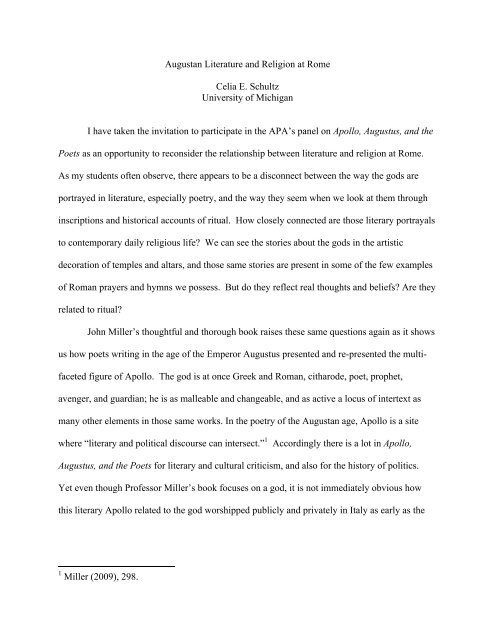
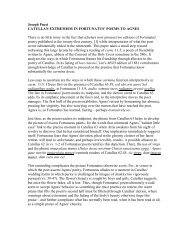
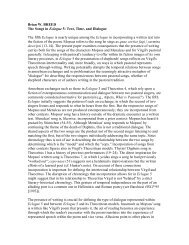
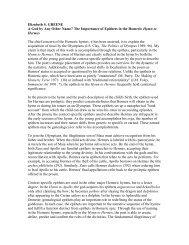
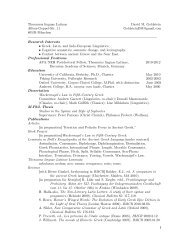
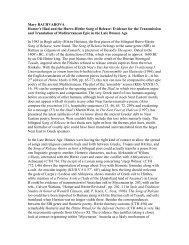

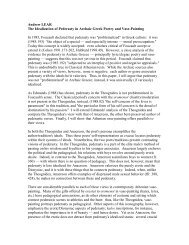
![John H. STARKS, Jr. [vo]cales vultus:Pantomime Actresses in Latin ...](https://img.yumpu.com/11930335/1/190x245/john-h-starks-jr-vocales-vultuspantomime-actresses-in-latin-.jpg?quality=85)
